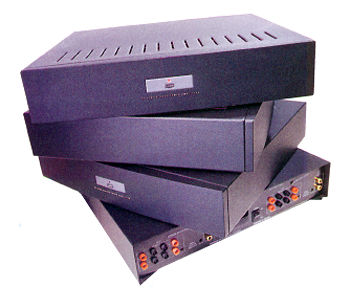Linn AV 51 System Page 2
From the remote or the front panel, you can adjust balance and volume, route the signal from and to any analog and/or digital components for recording (the 5103 performs A/D and D/A conversion), change surround modes, mute the signal, and select Standby mode. You can also enter the GUI and edit the system parameters.
For most buyers of a system like this, the comfort of surface simplicity served on an invisible bed of complex possibilities is very appealing. When the dealer slaps the remote in your hand, all speaker-configuration and level adjustments will have been made for you. In fact, once the dealer has set up the system, Linn doesn't want you messing with the sound. For example, the controller includes a Midnight Movie mode—essentially a compressor—but there's no cinema EQ to tame bright soundtracks. In fact, there are no equalization or tone controls of any kind, except for a 1dB treble-cut control on the crossover boards mounted inside the amplifiers.

The remote control is visually, physically, and ergonomically luxurious. Still, backlighting would be nice, as would a small LCD screen to compensate for the difficult-to-read controller panel. Of course, the easy-to-read GUI can be accessed from the remote, but you're out of luck if your antenna/cable source is directly connected to your monitor. That's my situation; while watching television, I had to stand up and move closer to the controller to see which surround mode I was in. This is not a major inconvenience, but you should know about it if you're considering spending big bucks.
The speakers
The 5140 is a fairly large, magnificent-looking, front-ported, floorstanding three-way design. Its 200mm rear-mounted, doped-paper woofer crosses over at 300Hz to a 100mm carbon-loaded, polypropylene midrange unit mounted above a 20mm ceramic-dome tweeter. This puts the space between the midrange and tweeter at about ear height. The midrange crosses over to the tweeter at 2.7kHz. Knuckle-rapping the substantial cabinet indicates that serious internal bracing has been applied.
The 5120 center-channel speaker is a dual front-ported design featuring the same midrange and tweeter used in the 5140. A pair of midrange drivers flank the tweeter in the classic D'Appolito configuration. It, too, is smart-looking and well-braced.
Because I was reviewing the "budget" $27,000 version of the Linn system, I was supplied with a pair of 5110 Local surround speakers. These are small, light, narrow, wedge-shaped, wall-mountable plastic models that the installer placed at ear level on a pair of stands borrowed from my recent review of the Sonus Faber Concerto system. The driver complement includes a 100mm die-cast bass/ midrange unit crossed over to a 10mm polymer-dome tweeter.
Topping off—or should I say bottoming out—the system is the 5150 Active Isobarik Bass subwoofer. This 100-pound work of art contains a pair of ported, 12" polypropylene woofers (operating out of phase with each other) powered by a 200W amplifier. Its flexible controls let the dealer adjust the sub until the desired result is achieved. These controls include upper-frequency rolloff, output impedance (electronic damping), phase, and level.









































